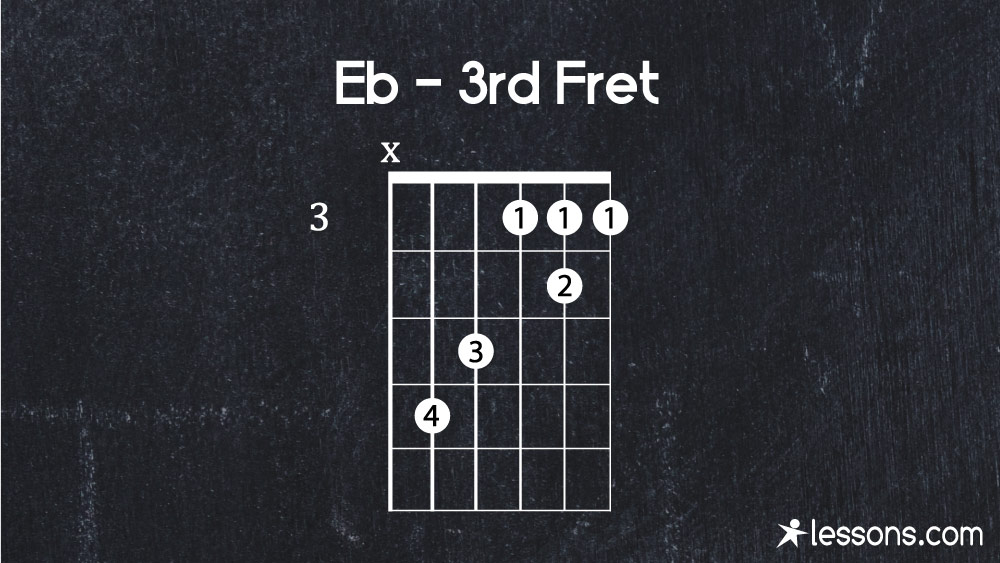Eb Guitar Chord | 8 Best Ways to Play (with Charts)
Eb Guitar Chord
In this lesson, we'll be taking a look at the Eb Major chord, which consists of three notes: "Eb," "G," and "Bb." It's not what you'd consider the most popular of chords, and, depending on what genre you're into, you might run into it only occasionally.
Jazz players are a bit more likely to encounter Eb Major, but even if you mostly stick to rock, blues, and pop, you'll want to have this chord (and its many voicings) at your disposal, so you aren't caught unawares. Like most other chords, there are a few easy ways to go about Eb, and a few challenging ones as well, so let's get into it.
How to Play Eb Guitar Chord
Unlike some other chords, which have a plethora of open position variations you can learn, there's only one go-to that most guitarists make use of for Eb in open position, and it'll require a bit of a stretch:

Place your 1st finger on the 4th string/1st fret
Place your 2nd finger on the 3rd string/3rd fret
Place your 3rd finger on the 1st string/3rd fret
Place your 4th finger on the 2nd string/4th fret
Mute strings 5 and 6
Avoiding the 5th and 6th string for this voicing shouldn't be too difficult. Keeping your 1st, 2nd and 3rd fingers in place while you reach up the fretboard with your 4th finger might post a greater challenge, however! Try to do some hand exercises and pinky drills to build your dexterity if you're having issues.
Eb Guitar Guitar Chord - Barre #1
Now, while the voicing above might be the only open position variant you'll be using, it's not the only voicing period. It might not even be the most popular, as many guitarists prefer to play Eb as a barre chord. You've got two options if you choose to go that route, with the first being on the 7th fret:

Use your 1st finger to bar the strings at the 6th fret
Place your 2nd finger on the 4th string/8th fret
Place your 3rd finger on the 3rd string/8th fret
Place your 4th finger on the 2nd string/8th fret
Mute string 6
Eb Major Guitar Chord - Barre #2
You might notice this as the "A-shape" barre chord, a prominent option for Major chord voicings using 5 strings. You can also use the 6-string, "E-shape" barre chord for Eb, up at the 11th fret:

Use your 1st finger to bar the strings at the 11th fret
Place your 2nd finger on the 3rd string/12th fret
Place your 3rd finger on the 5th string/13th fret
Place your 4th finger on the 4th string/13th fret
Those barre chords shouldn't pose much of an issue if you've already mastered how to play them (if you haven't, be sure to refresh your memory on how it's done and get to practicing).
E Flat Guitar Chord
With the basic versions of Eb Major out of the way, though, how about we move on to some more complex voicings?
E Flat Guitar Chord - 3rd Fret
The first we'll explore you can find at the 3rd fret:

Use your 1st finger to cover strings 1, 2, and 3 at the 3rd fret
Place your 2nd finger on the 2nd string/4th fret
Place your 3rd finger on the 4th string/5th fret
Place your 4th finger on the 5th string/6th fret
Mute string 6
Not only will you be reaching up the fretboard to play this chord, but you'll also be reaching across it -- hope you've been stretching and building your finger strength!
E Flat Guitar Chord - 4th Fret
If you find the previous voicing too straightforward, however, and want to add some trickier muting patterns into the equation, you can try these two voicings, on the 4th and 5th frets, respectively:

Place your 1st finger on the 2nd string/4th fret
Place your 2nd finger on the 4th string/5th fret
Place your 3rd finger on the 5th string/6th fret
Place your 4th finger on the 1st string/6th fret
Mute strings 3 and 6
E Flat Guitar Chord - 5th Fret

Place your 1st finger on the 4th string/5th fret
Place your 2nd finger on the 5th string/6th fret
Place your 3rd finger on the 1st string/6th fret
Mute strings 2, 3, and 6
E Flat Major Guitar Chord - Compact
If you're looking for a tight, compact version of Eb Major to play that avoids using your highest and lowest string, you can find that on the 6th fret:

Place your 1st finger on the 5th string/6th fret
Place your 2nd finger on the 4th string/8th fret
Place your 3rd finger on the 3rd string/8th fret
Place your 4th finger on the 2nd string/8th fret
Mute strings 1 and 6
E Flat Major Guitar Chord - Stretch
Last, but not least, the mother of all stretches (as far as Eb is concerned), which you can attempt on the 8th fret:

Place your 1st finger on the 4th string/8th fret
Place your 2nd finger on the 5th string/10th fret
Place your 3rd finger on the 6th string/11th fret
Place your 4th finger on the 2nd string/11th fret
Play string 3 open
Mute string 1
This is a tricky one, so don't get discouraged if you can't nail it right away.
Play Your Chords Like a Pro
Eb Major has even more voicings you can learn, so we encourage you to keep exploring and adding as many to your repertoire as possible. With each new variant you bring to your arsenal, your dedication to learning them right will make the difference between sounding average and playing your chords like a pro. As always, good luck, and happy practicing!